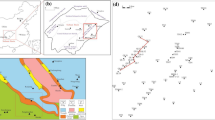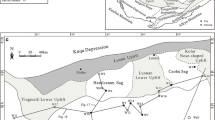Abstract
Based on cores, well logs and seismic data, we established the isochronous sequence stratigraphic framework of the Lower Silurian Longmaxi Formation and predicted the shale lithofacies distribution within the sequence stratigraphic framework using geostatistical inversion. The results of our study show that the Lower Member of the Longmaxi Formation is a third order sequence that includes a transgressive systems tract (TST), an early highstand systems tract (EHST) and a late highstand systems tract (LHST). Four lithofacies units have been recognized, specifically siliceous shale, argillaceous shale, calcareous shale and mixed shale. The results of geostatistical inversion reveal that the TST is characterized by flaky siliceous shale and some sparsely distributed calcareous shale. The EHST is dominated by mixed shale with minor amounts of siliceous shale, which occurs in only a small area. Moreover, in the LHST, argillaceous shale occupies almost the entire study region. Comparing to traditional geological research with geophysical research, the vertical resolution of the predictive results of geostatistical inversion could reach 1–2 m. Geostatistical inversion effectively solves the problem of precisely identifying the lithofacies in the Fuling shale gas field and predicting their spatial distribution. This successful study showcases the potential of this method for carrying out marine shale lithofacies prediction in China and other locations with similar geological backgrounds.


















Similar content being viewed by others
References
Aplin AC, Macquaker JHS (2011) Mudstone diversity: Origin and implications for source, seal, and reservoir properties in petroleum systems. AAPG Bull 95(12):2031–2059. doi:10.1306/03281110162
Bosch M, Mukerji T, Gonzalez EF (2010) Seismic inversion for reservoir properties combining statistical rock physics and geostatistics: a review. Geophysics 75(5):75A165–75A176. doi:10.1190/1.3478209
Campbell TJ, Richards FWB, Silva RL, Wach G, Eliuk L (2015) Interpretation of the penobscot 3d seismic volume using constrained sparse spike inversion, sable sub-basin, offshore nova scotia. Mar Pet Geol 68:73–93. doi:10.1016/j.marpetgeo.2015.08.009
Challands TJ, Armstrong HA, Maloney DP, Davies JR, Wilson D, Owen AW (2009) Organic-carbon deposition and coastal upwelling at mid-latitude during the Upper Ordovician (Late Katian): a case study from the Welsh Basin, UK. Palaeogeogr Palaeoclimatol Palaeoecol 273(3–4):395–410. doi:10.1016/j.palaeo.2008.10.004
Chen X, Rong JY, Li Y, Boucot AJ (2004) Facies patterns and geography of the Yangtze region, South China, through the Ordovician and Silurian transition. Palaeogeogr Palaeoclimatol Palaeoecol 204(3):353–372. doi:10.1016/S0031-0182(03)00736-3
Chen X, Melchin MJ, Sheets HD, Mitchell CE, Fan JX (2005) Patterns and process of latest Ordovician graptolite extinction and recovery based on data from South China. J Paleontol 79(5):842–861. doi:10.1666/0022-3360(2005)079[0842:PAPOLO]2.0.CO;2
Chen SB, Zhu YM, Wang HY, Liu HL, Wei W, Fang JH (2012a) Structure characteristics and accumulation significance of nanopores in Longmaxi shale gas reservoir in the southern Sichuan Basin. J China Coal Soc 37:438–444 (Chinese with English abstract)
Chen H, Xie XN, Hu CY, Huang JH, Li HJ (2012b) Geochemical characteristics of late Permian sediments in the Dalong formation of the Shangsi section, Northwest Sichuan Basin in south China: implications for organic carbon-rich siliceous rocks formation. J Geochem Explor 112(1):35–53. doi:10.1016/j.gexplo.2011.06.011
Chen L, Lu YC, Jiang S, Li JQ, Guo TL, Xing FC (2015) Sequence stratigraphy and its application in marine shale gas exploration: a case study of the Lower Silurian Longmaxi Formation in the Jiaoshiba shale gas field and its adjacent area in southeast Sichuan Basin, SW China. J Nat Gas Sci Eng 27(2):410–423. doi:10.1016/j.jngse.2015.09.016
Correia P, Azevedo L, Nunes RFM, Soares A, Guerreiro L, Neto GS (2014) Multidimensional scaling for the evaluation of a geostatistical seismic elastic inversion methodology. Geophysics 79(1):M1–M10. doi:10.1190/geo2013-0037.1
Dafflon B, Irving J, Barrash W (2010) Inversion of multiple intersecting high-resolution crosshole GPR profiles for hydrological characterization at the boise hydrogeophysical research site. J Appl Geophys 73(4):305–314. doi:10.1016/j.jappgeo.2011.02.001
Dubrule O, Thibaut M, Lamy P, Hass A (1998) Geostatistical reservoir characterization constrained by 3D seismic data. Pet Geosci 4(2):121–128. doi:10.1144/petgeo.4.2.121
Guo TL, Zhang HR (2014) Formation and enrichment mode of Jiaoshiba shale gas field, Sichuan Basin. Pet Explor Dev 41(1):31–40. doi:10.1016/S1876-3804(14)60003-3
Hass A, Dubrule O (1994) Geostatistical inversion-A sequential method for stochastic reservoir modeling constrained by seismic data. First Break 12(11):561–569. doi:10.3997/1365-2397.1994034
Helgesen J (2000) Comparison of constrained sparse spike and stochastic inversion for porosity prediction at kristin field. Leading Edge, 19(4), 400, 403–404, 406–407
John S (1986) Lithofacies types and vertical profile models; an alternative approach to the description and environmental interpretation of glacial diamict and diamictic sequences. Sedimentology 33(1):151–155. doi:10.1111/j.1365-3091.1986.tb00751.x
John AK, Lake LW, Torres-Verdin C, Srinivasan S (2008) Seismic facies identification and classification using simple statistics. SPE Reserv Eval Eng 11(6):984–990. doi:10.2118/96577-PA
Kadkhodaie-Ilkhchi A, Monteiro ST, Ramos F, Hatherly P (2010) Rock recognition from MWD data: a comparative study of boosting, neural networks, and fuzzy logic. IEEE Geosci Remote Sens Lett 7(4):680–684. doi:10.1109/LGRS.2010.2046312
Kametaka M, Takebe M, Nagai H, Zhu SZ, Takayanagi Y (2005) Sedimentary environments of the Middle Permian phosphorite–chert complex from the northeastern Yangtze platform, China; the Gufeng Formation: a continental shelf radiolarian chert. Sediment Geol 174(3–4):197–222. doi:10.1016/j.sedgeo.2004.12.005
Larsen AL, Ulvmoen M, Omre H, Buland A (2006) Bayesian lithology/fluid prediction and simulation on the basis of a Markov-chain prior model. Geophysics 71(5):R69–R78. doi:10.1190/1.2245469
Liang DG, Guo TL, Bian LZ, Chen JP, Zhao Z (2009) Some progress on studies of hydrocarbon generation and accumulation in marine sedimentary regions, Southern China (part 3): controlling factors on the sedimentary facies and development of Palaeozoic marine source rocks. Mar Orig Pet Geol 14:1–19 (Chinese with English abstract)
Liu SG, Wang SY, Sun Y, Ran B, Yang D, Luo C, Ye YH, Bai ZQ, Qiu JW, Zhang X (2013) Characteristics of black shale in Wufneg Formation and Longmaxi Formation in Sichuan Basin and its Peripheral areas. J Chengdu Univ Technol 40(6):621–639 (in Chinese with English abstract). doi:10.3969/j.issn.1671-9727.2013.06.02
Loucks RG, Ruppel SC (2007) Mississippian Barnett Shale: Lithofacies and depositional setting of a deep-water shale-gas succession in the Fort Worth Basin, Texas. AAPG Bulletin 91(4):579–601
Ma YQ, Fan MJ, Lu YC, Guo XS, Hu HY, Chen L, Wang C, Liu XC (2016) Geochemistry and sedimentology of the lower silurian longmaxi mudstone in southwestern china: implications for depositional controls on organic matter accumulation. Mar Pet Geol 75:291–309. doi:10.1016/j.marpetgeo.2016.04.024
Ma YQ, Fan MJ, Lu YC, Liu HM, Hao YQ, Xie ZH, Peng L, Du XB, Hu HY (2017) Middle Eocene paleohydrology of the Dongying depression in eastern China from sedimentological and geochemical signatures of lacustrine mudstone. Palaeogeogr Palaeoclimatol Palaeoecol. doi:10.1016/j.palaeo.2017.04.011
Maiti S, Tiwari RK (2009) A Hybrid Monte Carlo method based artificial neural networks approach for rock boundaries identification: a case study from KTB borehole. Pure Appl Geophys 166:2059–2090. doi:10.1007/s00024-009-0533-y
Maiti S, Tiwari RK (2010a) Automatic discriminations among geophysical signals via the Bayesian neural networks approach. Geophysics 3298501(1):2010
Maiti S, Tiwari RK (2010b) Neural network modeling and an uncertainty analysis in Bayesian framework: a case study from the KTB borehole site. J Geophys Res 115:B10208. doi:10.1029/2010JB000864
Maiti S, Tiwari RK, Kuempel H-J (2007) Neural network modeling and classification of litho-facies using well log data: a case study from KTB borehole site. Geophys J Int. doi:10.1111/j.1365-246X.2007.03342.x
Ojha M, Maiti S (2013) Sediment classification using neural networks: an example from the site-U1344A of IODP Expedition 323 in the Bering Sea. Deep-Sea Research Part II: topical Studies. Oceanography 125–126(7):202–213. doi:10.1016/j.dsr2.2013.03.024
Riboulleau A, Baudin F, Deconinck J-F, Derenne S, Largeau C, Tribovillard N (2003) Depositional conditions and organic matter preservation pathways in an epicontinental environment: the Upper Jurassic Kashpir Oil Shales (Volga Basin, Russia). Palaeogeogr Palaeoclimatol Palaeoecol 197(3–4):171–197. doi:10.1016/S0031-0182(03)00460-7
Rimstad K, Omre H (2009) Impact of rock-physics depth trends and Markov random fields on hierarchical Bayesian lithology/fluid prediction. Geophysics 75(4):R93–R108. doi:10.1190/1.3463475
Rong JY, Chen X, Wang Y (2011) Northward expansion of Central Guizhou Oldland through the Ordovician and Silurian transition: evidence and implications. Sci China Earth Sci 41(10):1407–1415 (Chinese with English abstract)
Slatt RM, Rodriguez ND (2012) Comparative sequence stratigraphy and organic geochemistry of gas shales: commonality or coincidence. J Nat Gas Sci Eng 8:68–84. doi:10.1016/j.jngse.2012.01.008
Tang H, White CD (2008) Multivariate statistical log log-facies classification on a shallow marine reservoir. J Petrol Sci Eng 61(2):88–93. doi:10.1016/j.petrol.2008.05.004
Tian H, Pan L, Xiao XM, Wilkins RWT, Meng ZP, Huang BJ (2013) A preliminary study on the pore characterization of Lower Silurian black shales in Chuandong Thrust Fold Belt, southwestern China using low pressure N2 adsorption and FE-SEM methods. Mar Pet Geol 48:8–19. doi:10.1016/j.marpetgeo.2013.07.008
Ulvmoe M, Omre H, Buland A (2010) Improved resolution in Bayesian lithology/fluid inversion from prestack seismic data and well observations: Part 2-Real case study. Geophysics 75(2):B73–B82. doi:10.1190/1.3335332
Vernengo L, Czeplowodzki R, Trinchero E, Sabaté A, Tsybulkina I, Morillo F (2014) Improvement of the reservoir characterization of fluvial sandstones with geostatistical inversion in Golfo San Jorge Basin, Argentina. Lead Edge 33(5):508–518. doi:10.1190/tle33050508.1
Wang GC, Carr TR (2012a) Methodology of organic-rich shale lithofacies identification and prediction: a case study from Marcellus Shale in the Appalachian Basin. Comput Geosci 49:151–163. doi:10.1016/j.cageo.2012.07.011
Wang GC, Carr TR (2012b) Marcellus Shale Lithofacies Prediction by Multiclass Neural Network Classification in the Appalachian Basin. Math Geosci 44(8):975–1004. doi:10.1007/s11004-012-9421-6
Wang GC, Carr TR (2013) Organic-rich marcellus shale lithofacies modeling and distribution pattern analysis in the appalachian basin. AAPG Bull 97(12):2173–2205
Wang YM, Dong DZ, Yang H, He L, Wang SQ, Huang JL, Pu BL, Wang SF (2013) Quantitative characterization of reservoir space in the Lower Silurian Longmaxi shale, southern Sichuan, China. Science China. Earth Sci 57(2):313–322. doi:10.1007/s11430-013-4645-y
Wang GC, Ju YW, Can TR, Tian FQ (2015) The hierarchical decomposition method and its application in recognizing Marcellus Shale lithofacies through combining with neural network. J Pet Sci Eng 127:469–481. doi:10.1016/j.petrol.2015.02.006
Xu XS, Liu W, Zhou DK, Wang GS, Zhang HQ, Shi GS (2009) Sedimentary facies of the Lower Silurian in central and southeastern Guizhou Province. J Palaeogeogr 11(1):13–20 (Chinese with English abstract)
Zhang R, Castagna J (2011) Seismic sparse-layer reflectivity inversion using basis pursuit decomposition. Geophysics 76(6):147. doi:10.1190/geo2011-0103.1
Zhang TW, Ellis GS, Ruppel SC, Milliken K, Yang R (2012) Effect of organic-matter type and thermal maturity on methane adsorption in shale-gas systems. Org Geochem 47(6):120–131. doi:10.1016/j.orggeochem.2012.03.012
Zhao LX, Geng JH, Cheng JB, Han DH, Guo TL (2014) Probabilistic lithofacies prediction from prestack seismic data in a heterogeneous carbonate reservoir. Geophysics 79(5):M25–M34. doi:10.1190/geo2013-0406.1
Acknowledgements
This study was funded by National Key Research Program of China (973 program) (2014CB239102), National Key Projects of Oil and Gas (2016ZX05034), National Natural Science Foundation of China (NSFC) programs (No. 41602147). Our special thanks are extended to Editor Roger Urgeles, as well as three anonymous reviewers, for many critical and constructive comments.
Author information
Authors and Affiliations
Corresponding author
Rights and permissions
About this article
Cite this article
Liu, X., Lu, Y., Lu, Y. et al. The application of geostatistical inversion in shale lithofacies prediction: a case study of the Lower Silurian Longmaxi marine shale in Fuling area in the southeast Sichuan Basin, China. Mar Geophys Res 39, 421–439 (2018). https://doi.org/10.1007/s11001-017-9317-4
Received:
Accepted:
Published:
Issue Date:
DOI: https://doi.org/10.1007/s11001-017-9317-4




